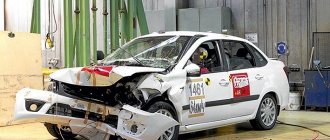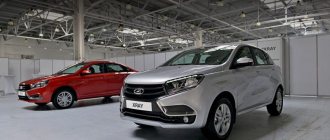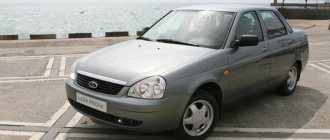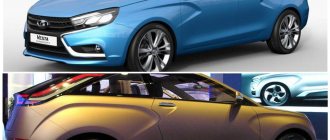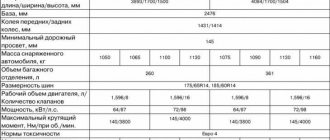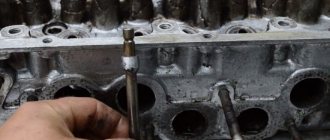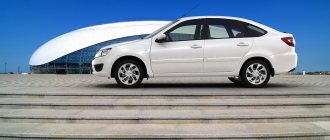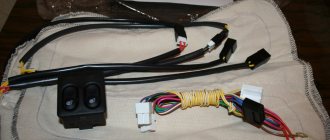Autoreview experts tested the safety of the all-terrain version of the tall hatchback, crashing it at a speed of 64 km/h.
The ARCAR technique involves a frontal impact on a deformable barrier with a 40% overlap at a speed of 64 km/h.
The XRay Cross completed this test with 13.7 points out of 16 possible, which corresponds to the maximum four stars. For comparison, the result of the Lada Vesta sedan was higher than that of the XRay - 15.1 points (four stars). And Renault Logan, built on the same B0 platform and tested back in 2005, “earned” only 11 points (three stars). XRay and Logan have significant design differences. Like, AvtoVAZ independently developed the subframe and front suspension for the Lada, and in addition, the Russian hatchback in the Cross version is 245 kg heavier than the Logan and has 17-inch wheels.
As a result of the impact with the barrier, “waves” appeared on the bottom of the XRay Cross, a wrinkle formed on the windshield pillar, and the doorway became 2 cm smaller. At the same time, the telescopic steering column mechanism, seat belt pretensioners and front airbags worked correctly.
There were no complaints about the safety of the passenger and driver. The published infographic shows that parts of the mannequins' torsos are colored green and yellow, which corresponds to "high" and "satisfactory" ratings.
As Autorambler reported, at the beginning of last year a video appeared with a crash test of another Lada model - the Vesta SW station wagon. This model earned only three ARCAP stars - 11.7 points.
Despite the fact that a crash test of the Lada X Ray has not yet been carried out, certain conclusions about what the manufacturer of this new car has prepared for us can be made today.
Technical features
The test presented the Lada X-Ray Cross, which combines a power body from Sandero and a subframe of VAZ’s own design. Who didn’t know, but the domestic automaker, no matter how much they scold it, devotes a lot of effort to the passive safety of its cars. In particular: they carry out mathematical modeling of a crash test and a computer calculation of possible damage.
A special feature of this model is that it weighs 200 kilograms more than the Sandero and has larger diameter front wheels (17 inches). As you know, it is the large diameter of the wheels that can change the picture of body deformation during a frontal impact for the worse, using the example of the UAZ Patriot. Therefore, the engineers from Avto-VAZ, with their fingers crossed, were waiting for the results of the Lada X Ray Cross crash test - let's see what happened.
Repair at the service center. Price
The service center usually replaces all damaged elements. And this, in turn, affects the cost of repairs, as well as time, because you often have to wait for the delivery of spare parts. From the damage listed above, you can understand which elements will need to be replaced. We will immediately indicate the cost of each part. So, to restore a car you will need:
- Hood ($185-210);
- Headlights 2 pcs. ($625-710);
- Left wing ($75-90);
- Cross beam ($210-250);
- Upper crossbar ($150-175);
- Front spar ($170-$190);
- Bumper ($165-280);
- Radiator grille ($20-25).
In general, you will have to spend from $1,600 to $1,930 on spare parts (it all depends on the suppliers). You will also have to pay the service for restoration - replacing damaged elements, editing some of them, painting work. The total cost of the work will cost about $850. In total, restoring a Lada X-Ray to its original condition in the event of such a minor collision will cost $2,450-$2,780 in service. And this is with the price of the car itself being $10,380-$13,850. That is, for restoration you will have to pay almost a quarter of the cost of the crossover.
results
Automatic activation of the Era-GLONASS system - we reject the emergency call. The first glance at the car after an impact makes experts wary - a small crease on the windshield pillar, for modern cars with strong bodies, this is not typical - a bad “bell”.
We look at the threshold on the driver's side - it has sagged a little, the driver's dummy is sitting low, its knees resting on the panel, the seat has sank down along with the floor. The door opened without the help of a special tool, but noticeably wedged in the opening. The passenger appears to be doing quite well based on a quick examination.
The front part of the car was crushed as much as possible in order to dissipate the force of the frontal impact and not transfer it to the power cell of the passenger compartment. The video shows how the spar has folded. But the deformation went further - the subframe folded, but not enough, and transferred the impact to the floor under the driver's seat, as evidenced by the folds in the bottom and the crease in the strength part of the frame. That's why the driver's seat sank.
Unlike the Lada Vesta Cross, which had tears in these places, the body of the X Ray remained intact. The video above clearly shows that the threshold of the car and its bottom were not torn apart after the crash test - there is a deflection, but the metal is intact. The engineers' fears about the enlarged front wheels, which could worsen the picture of body deformation in the driver's seat area, were not justified; everything is fine.
Separately, it is worth mentioning the restraint system of the safety system - airbags and belts with “pretension”. If we compare with French brands, then when the airbags deployed on Logan, the mannequin’s face suffered a strong blow, and the belts did not cope with their task - to protect against hitting the head on the airbag that had fired. In the Lada X Ray Cross, during the crash test, the airbags worked as expected by the engineers, and the belts worked as expected.
Testing "Lada X Ray"
One of the tasks that the Lada X Ray car was supposed to provide was guaranteed driver safety in any, even the most unfavorable situations. To achieve this, the car was equipped with effective security systems. AvtoVAZ believes that when passing the most prestigious crash test in the Euro NCAP rating, the Lada X Ray should receive three stars. A high score obtained as a result of passing this test opens the vehicle to the world market, as it is regarded by everyone as a kind of “Sign of Quality”.
The Lada X Ray is awaiting crash testing according to the RCAR and ARCAR methods.
Crash test criteria
When passing a crash test in the Euro NCAP rating, the car is subjected to tests, based on the results of which experts evaluate:
- child safety;
- driver protection;
- passenger safety;
- the danger a vehicle poses to pedestrians.
Design solutions ensuring the safety of the driver and passengers
The developers of the Lada X Ray car laid down a high level of safety at the design stage. In addition, the car has a reinforced body equipped with a number of structural elements that improve safety. These include:
- built-in roof reinforcements;
- safety bars in all doors;
- additional protective beams in bumpers;
- side body pillars.
During the development process, many parts were tested using a computer and only then embodied in metal.
Successful completion of a crash test is impossible without equipping the vehicle with passive safety systems. The use of the well-known VO platform as a layout diagram made it possible to equip the vehicle with a large number of such systems, including:
- effective system for securing child seats;
- three-point inertial seat belts for the driver and all passengers;
- belt tensioners;
- L-shaped headrests;
- automatic door unlocking upon impact;
- front and side airbags.
The car is also equipped with the most modern electronic safety systems, including ABS, EBD, BAS, ESP, TCS, etc.
Crash test methods
In world practice, the term “crash test” is used to refer to testing vehicles for safety. These tests simulate different types of road traffic accidents in order to find out what kind of damage those involved can suffer. In this case, instead of living people, special mannequins are used. There are a large number of different types of crash tests, but the most common are tests carried out using the following methods:
- Euro NCAP methodology. The modern, most prestigious type of comprehensive testing, which includes:
- frontal collision at a speed of 64 km/h with a deformable barrier, with the impact occurring at 40% of the width of the front of the vehicle (driver's side);
- side collision at a speed of 55 km/h with a deformable barrier;
- head-on collision at a speed of 55 km/h with a rigid barrier.
conclusions
Lada X-Ray Cross receives 13.7 points out of 16 possible for protecting front seat belts from a frontal impact. This is 4 stars out of a possible four according to the ARCAP system from Autoreview magazine. It ranks 5th in the safety rating. Above are the Volkswagen Polo Sedan, Lada Vesta, Hyundai Creta and Solaris.
to experts, the results of the Lada X Ray Cross crash test are affected by the outdated French B0 platform. The body can withstand the blow, but without reserve, and the Koreans produce the next generation of bodies, which are more durable. On the other hand, the Brazilian-built Renault Sandero, the progenitor of the X-Ray, performed worse in the Latin American Latin NCAP rating - 8 points out of 16 possible. So the body received fines for violating the structural value; the base does not have seat belt pretensioners or limiters. Let's say thank you to the alliance for being more concerned about the safety of Russian car owners.
What experts say
Today, absolutely every car enthusiast knows that the basis of the first Russian crossover was the Renault Duster and Lada C-Cross, which was introduced several years ago. There is a certain similarity between these machines, you just have to look closely at the photo.
It is worth recalling that Renault Duster was able to pass the safety tests only with a weak “C”. However, if for a foreign crossover a three on the NCAP scale is not the ultimate dream, then for Lada cars this is simply an excellent result.
Crash test of Lada Xray using the RCAR method: how much will the repair cost?
Lada Xray passed the “insurance” crash test using the RCAR method. How much will it cost to restore it after a frontal impact at a speed of 15 km/h?
The bumper holds tightly to the wings - and transfers part of the impact energy to them
After meeting the barrier, XRAY waved its brushes in surprise: as happened on potholes on a cobblestone road, the shock caused the steering column lever to jump. Damage? The bumper cover was cracked, the hood was dented, the headlight was askew—we've seen worse faces after such blows. But there are small dents on both front fenders: this was done by the lining, which grabbed them with a death grip.
Articles about tuning Lada Xray
Disabling the automatic activation of the rear wiper on the Lada XRAY
Installing additional trunk lighting on the Lada XRAY
Installing an additional seal in the engine compartment of Lada XRAY
Car front strut strut: purpose, installation and reviews
But what’s worse is that the left wing, which had moved back, blocked the driver’s door, and the hood, which rested against the same wing near the windshield pillar, prevented the wing from being loosened and moved slightly forward. So we had to evacuate the dummy through the passenger door, get behind the wheel in the same manner and go to our technical center - fortunately, nothing leaked or fell off under the hood of Ixray.
It was possible to open the hood only by moving it a centimeter in its attachment to the left hinge
It was possible to break the closed, or rather, blocked circle, only with difficulty reaching the fastening of the hood to the left hinge: first they broke it, and then, by slightly moving the wing, the door.
The left wing was also damaged at the point of attachment to the mudguard.
And having finally separated the bumper lining from the wings, Uncle Vanya already whistled: immediately behind the left edge of the fairly dented cross beam, the designers installed an electronic transmission control unit and an electric power steering pump along with a reservoir. It’s good that both units escaped with only bent mounting brackets. What if the blow was more serious?
After all, XRAY is not Vesta; it is made from a different, looser dough. After similar blows to the related Nissan Almera, Renault Sandero and Duster, we dubbed the design of the front of the B0 platform plasticine - and XRAY, alas, was no exception. True, the cross beam on the Lada, unlike its counterparts, is conditionally removable: it is attached to the ends of the side members with bolts instead of welding. Why conditional? Because for the sake of structural strength, the beam, in addition to the fasteners, is placed on such a generous layer of sealant that tearing it off is no easier than cutting it off.
